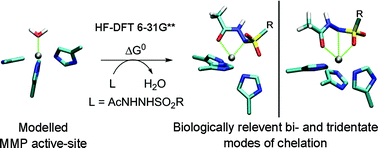In silico study of MMP inhibition†
Abstract
Lack of enzyme inhibition selectivity is frequently the major drawback preventing the development of

* Corresponding authors
a
ICMR, CNRS UMR6229, UFR Pharmacie, Université de Reims Champagne-Ardenne, 51 Rue Cognacq Jay, Reims Cedex, France
E-mail:
dominique.guillaume@univ-reims.fr
Fax: +33 326 918 029
b LACM-DTI, EA 3304 URA CEA-Université LRC DSM 0534, Equipe de Chimie Théorique, UFR Sciences Exactes et Naturelles, Université de Reims Champagne-Ardenne, Moulin de la Housse BP 1039, Reims Cedex 2, France
Lack of enzyme inhibition selectivity is frequently the major drawback preventing the development of

 Please wait while we load your content...
Something went wrong. Try again?
Please wait while we load your content...
Something went wrong. Try again?
M. Rouffet, C. Denhez, E. Bourguet, F. Bohr and D. Guillaume, Org. Biomol. Chem., 2009, 7, 3817 DOI: 10.1039/B910543C
To request permission to reproduce material from this article, please go to the Copyright Clearance Center request page.
If you are an author contributing to an RSC publication, you do not need to request permission provided correct acknowledgement is given.
If you are the author of this article, you do not need to request permission to reproduce figures and diagrams provided correct acknowledgement is given. If you want to reproduce the whole article in a third-party publication (excluding your thesis/dissertation for which permission is not required) please go to the Copyright Clearance Center request page.
Read more about how to correctly acknowledge RSC content.
 Fetching data from CrossRef.
Fetching data from CrossRef.
This may take some time to load.
Loading related content
